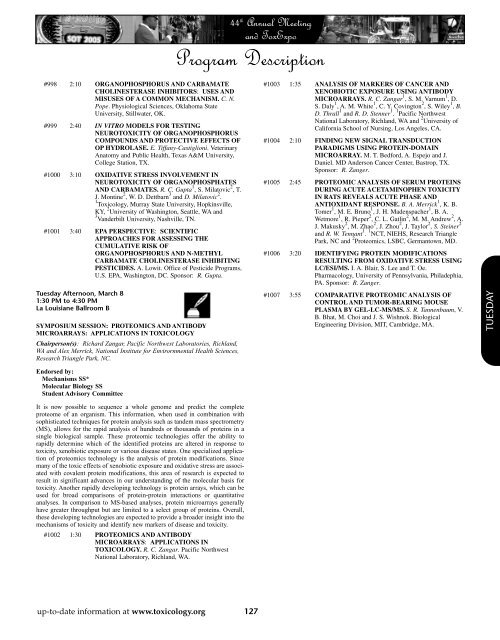Program - Society of Toxicology
Program - Society of Toxicology
Program - Society of Toxicology
You also want an ePaper? Increase the reach of your titles
YUMPU automatically turns print PDFs into web optimized ePapers that Google loves.
44 th Annual Meeting<br />
and ToxExpo<br />
<strong>Program</strong> Description<br />
#998 2:10 ORGANOPHOSPHORUS AND CARBAMATE<br />
CHOLINESTERASE INHIBITORS: USES AND<br />
MISUSES OF A COMMON MECHANISM. C. N.<br />
Pope. Physiological Sciences, Oklahoma State<br />
University, Stillwater, OK.<br />
#999 2:40 IN VITRO MODELS FOR TESTING<br />
NEUROTOXICITY OF ORGANOPHOSPHORUS<br />
COMPOUNDS AND PROTECTIVE EFFECTS OF<br />
OP HYDROLASE. E. Tiffany-Castiglioni. Veterinary<br />
Anatomy and Public Health, Texas A&M University,<br />
College Station, TX.<br />
#1000 3:10 OXIDATIVE STRESS INVOLVEMENT IN<br />
NEUROTOXICITY OF ORGANOPHOSPHATES<br />
AND CARBAMATES. R. C. Gupta 1 , S. Milatovic 2 , T.<br />
J. Montine 2 , W. D. Dettbarn 3 and D. Milatovic 2 .<br />
1 <strong>Toxicology</strong>, Murray State University, Hopkinsville,<br />
KY, 2 University <strong>of</strong> Washington, Seattle, WA and<br />
3 Vanderbilt University, Nashville, TN.<br />
#1001 3:40 EPA PERSPECTIVE: SCIENTIFIC<br />
APPROACHES FOR ASSESSING THE<br />
CUMULATIVE RISK OF<br />
ORGANOPHOSPHORUS AND N-METHYL<br />
CARBAMATE CHOLINESTERASE INHIBITING<br />
PESTICIDES. A. Lowit. Office <strong>of</strong> Pesticide <strong>Program</strong>s,<br />
U.S. EPA, Washington, DC. Sponsor: R. Gupta.<br />
Tuesday Afternoon, March 8<br />
1:30 PM to 4:30 PM<br />
La Louisiane Ballroom B<br />
SYMPOSIUM SESSION: PROTEOMICS AND ANTIBODY<br />
MICROARRAYS: APPLICATIONS IN TOXICOLOGY<br />
Chairperson(s): Richard Zangar, Pacific Northwest Laboratories, Richland,<br />
WA and Alex Merrick, National Institute for Envirornmental Health Sciences,<br />
Research Triangle Park, NC.<br />
#1003 1:35 ANALYSIS OF MARKERS OF CANCER AND<br />
XENOBIOTIC EXPOSURE USING ANTIBODY<br />
MICROARRAYS. R. C. Zangar 1 , S. M. Varnum 1 , D.<br />
S. Daly 1 , A. M. White 1 , C. Y. Covington 2 , S. Wiley 1 , B.<br />
D. Thrall 1 and R. D. Stenner 1 . 1 Pacific Northwest<br />
National Laboratory, Richland, WA and 2 University <strong>of</strong><br />
California School <strong>of</strong> Nursing, Los Angeles, CA.<br />
#1004 2:10 FINDING NEW SIGNAL TRANSDUCTION<br />
PARADIGMS USING PROTEIN-DOMAIN<br />
MICROARRAY. M. T. Bedford, A. Espejo and J.<br />
Daniel. MD Anderson Cancer Center, Bastrop, TX.<br />
Sponsor: R. Zanger.<br />
#1005 2:45 PROTEOMIC ANALYSIS OF SERUM PROTEINS<br />
DURING ACUTE ACETAMINOPHEN TOXICITY<br />
IN RATS REVEALS ACUTE PHASE AND<br />
ANTIOXIDANT RESPONSE. B. A. Merrick 1 , K. B.<br />
Tomer 1 , M. E. Bruno 1 , J. H. Madenspacher 1 , B. A.<br />
Wetmore 1 , R. Pieper 2 , C. L. Gatlin 2 , M. M. Andrew 2 , A.<br />
J. Makusky 2 , M. Zhao 2 , J. Zhou 2 , J. Taylor 2 , S. Steiner 2<br />
and R. W. Tennant 1 . 1 NCT, NIEHS, Research Triangle<br />
Park, NC and 2 Proteomics, LSBC, Germantown, MD.<br />
#1006 3:20 IDENTIFYING PROTEIN MODIFICATIONS<br />
RESULTING FROM OXIDATIVE STRESS USING<br />
LC/ESI/MS. I. A. Blair, S. Lee and T. Oe.<br />
Pharmacology, University <strong>of</strong> Pennsylvania, Philadephia,<br />
PA. Sponsor: R. Zanger.<br />
#1007 3:55 COMPARATIVE PROTEOMIC ANALYSIS OF<br />
CONTROL AND TUMOR-BEARING MOUSE<br />
PLASMA BY GEL-LC-MS/MS. S. R. Tannenbaum, V.<br />
B. Bhat, M. Choi and J. S. Wishnok. Biological<br />
Engineering Division, MIT, Cambridge, MA.<br />
TUESDAY<br />
Endorsed by:<br />
Mechanisms SS*<br />
Molecular Biology SS<br />
Student Advisory Committee<br />
It is now possible to sequence a whole genome and predict the complete<br />
proteome <strong>of</strong> an organism. This information, when used in combination with<br />
sophisticated techniques for protein analysis such as tandem mass spectrometry<br />
(MS), allows for the rapid analysis <strong>of</strong> hundreds or thousands <strong>of</strong> proteins in a<br />
single biological sample. These proteomic technologies <strong>of</strong>fer the ability to<br />
rapidly determine which <strong>of</strong> the identified proteins are altered in response to<br />
toxicity, xenobiotic exposure or various disease states. One specialized application<br />
<strong>of</strong> proteomics technology is the analysis <strong>of</strong> protein modifications. Since<br />
many <strong>of</strong> the toxic effects <strong>of</strong> xenobiotic exposure and oxidative stress are associated<br />
with covalent protein modifications, this area <strong>of</strong> research is expected to<br />
result in significant advances in our understanding <strong>of</strong> the molecular basis for<br />
toxicity. Another rapidly developing technology is protein arrays, which can be<br />
used for broad comparisons <strong>of</strong> protein-protein interactions or quantitative<br />
analyses. In comparison to MS-based analyses, protein microarrays generally<br />
have greater throughput but are limited to a select group <strong>of</strong> proteins. Overall,<br />
these developing technologies are expected to provide a broader insight into the<br />
mechanisms <strong>of</strong> toxicity and identify new markers <strong>of</strong> disease and toxicity.<br />
#1002 1:30 PROTEOMICS AND ANTIBODY<br />
MICROARRAYS: APPLICATIONS IN<br />
TOXICOLOGY. R. C. Zangar. Pacific Northwest<br />
National Laboratory, Richland, WA.<br />
up-to-date information at www.toxicology.org 127

















